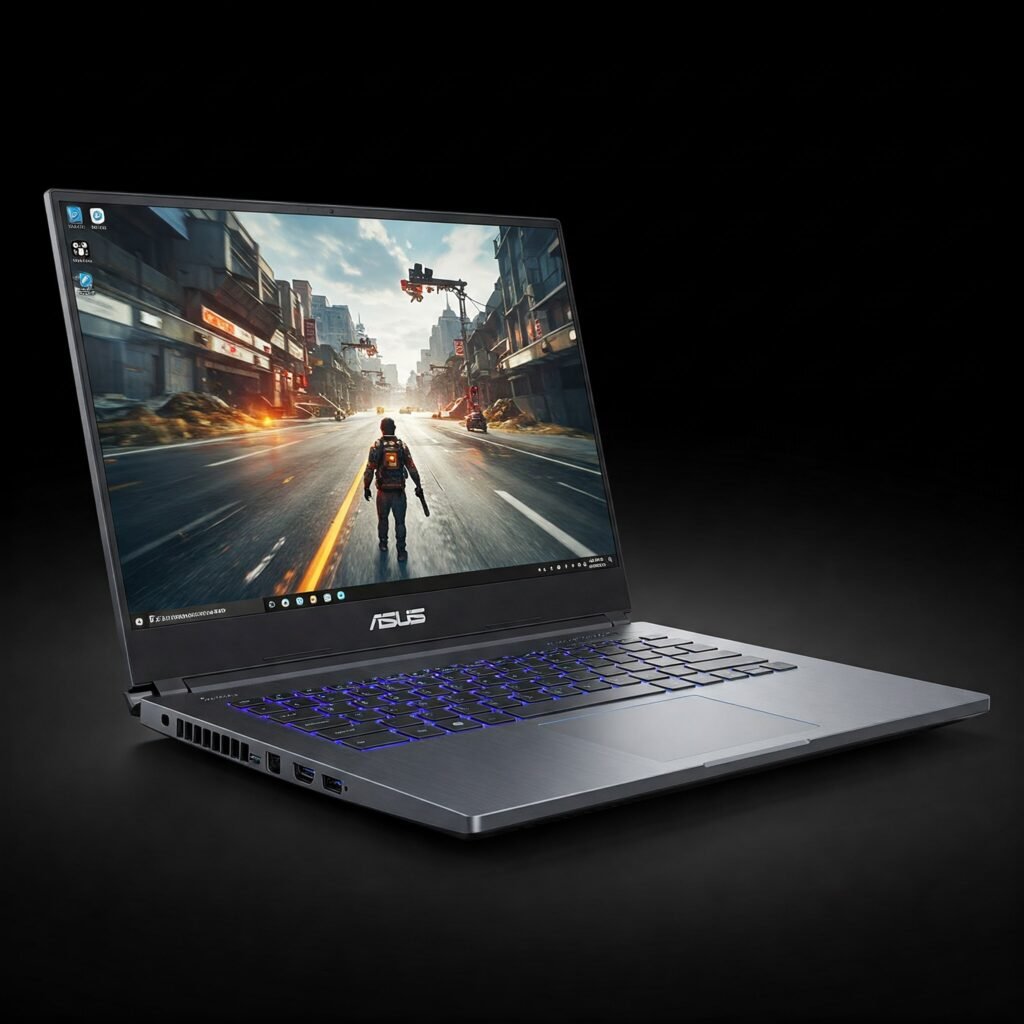Level Up Your Wishlist: Why Your Next Gaming Laptop (Late 2025/2026) Will Be Worth the Wait!
Alright, fellow gamers and power users, let’s talk. You’ve seen the current crop of high-end gaming laptops – sleek machines packing serious punch with RTX 40-series cards and powerful CPUs. They’re awesome, no doubt. But maybe, just maybe, you’re holding out? Perhaps you’re sensing that the next big leap is just over the horizon? If that sounds like you, grab your energy drink, because the generation of flagship gaming laptops expected around late 2025 or early 2026 is shaping up to be absolutely monumental.
Get ready to start dreaming (and maybe saving up), because here’s what we anticipate will make these future machines the new kings of portable power.
- Prepare for Warp Speed: The CPU & GPU Revolution
- A Feast for Your Eyes: Displays That Defy Reality
- Chilling Out: Advanced Thermals for Ferocious Hardware
- The Speedy Supporting Cast: RAM, Storage, Connectivity
- The Burning Question: What Will These Future Beasts Cost?
- The AI Edge: More Than Just Frames
- Conclusion: Start Dreaming (and Saving!)
1. Prepare for Warp Speed: The CPU & GPU Revolution
This is where the silicon sorcery happens, pushing performance to levels that border on the unbelievable. Get ready for:
- Next-Gen CPUs – Beyond the Hype: Imagine Intel’s future mobile chips (think successors to Core i9 HX based on architectures potentially like “Lunar Lake” or “Arrow Lake” built on cutting-edge 2nm-class process nodes) boasting even higher core counts (pushing beyond 24 hybrid cores?) and significantly improved Instructions Per Clock (IPC). Similarly, expect AMD’s next evolution (perhaps “Zen 6” based Ryzen 9 HX chips?) to bring its own multi-core fury and efficiency gains. We’re already flirting with 6GHz boost clocks now; the next generation could realistically smash past 6GHz peaks more regularly, fueled by larger L3 caches (maybe 48MB+?) and refined boosting algorithms. What does this translate to? Blistering single-core speed for snappier everything and higher FPS in CPU-bound games, plus monstrous multi-core power for streaming, content creation, and complex simulations running smoother than ever.
- NVIDIA RTX 50-Series Mobile – Prepare for Visual Overload: Buckle up. We’re eagerly anticipating the mobile versions of NVIDIA’s next architecture (likely the successor to “Blackwell”), bringing us the GeForce RTX 5080 and RTX 5090 laptop GPUs. Expect a staggering leap in performance, potentially fueled by significantly more CUDA cores, next-generation RT cores delivering even more realistic hardware-accelerated ray tracing, and massively enhanced Tensor Cores. We could see theoretical compute performance (TFLOPs) jump significantly, enabling unprecedented visual fidelity. Imagine 16GB to 20GB (or more!) of faster GDDR7 VRAMbecoming standard on these top tiers, annihilating texture memory limits. Combine this with next-gen DLSS (DLSS 4?) utilizing that AI prowess for potentially mind-blowing frame generation and image quality, making silky-smooth 4K gaming at max settings with ray tracing the new benchmark for high-end mobile play.
2. A Feast for Your Eyes: Displays That Defy Reality
Your games need a canvas worthy of the power driving them:
- Pixel Perfection: QHD+ (2560×1600) or even 4K (3840×2400) resolutions at 240Hz+ refresh rates will be table stakes. Expect lightning-fast pixel response times (aiming for sub-3ms GtG) for crystal-clear motion.
- HDR Glory: Vibrant Mini-LED displays with hundreds or thousands of dimming zones could become the default, pushing brightness and contrast further towards DisplayHDR 1000 certification or beyond. High-refresh OLED panels tuned for gaming might also become more common in various sizes. Look for true 10-bit color depthbecoming standard for smoother gradients.
- Immersive Formats: The move to taller 16:10 aspect ratios will continue, and glorious 18-inch panels might solidify their place in the flagship tier.
3. Chilling Out: Advanced Thermals for Ferocious Hardware
Taming these beasts requires serious cooling innovation:
- Exotic Cooling Standard: Expect expanded vapor chambers, intricate networks of 5+ heat pipes, widespread use of high-performance liquid metal thermal compounds (like Thermal Grizzly Conductonaut Extreme or similar) applied from the factory, and potentially refined arc-flow fans with higher blade density for increased airflow without excessive noise.
- Liquid’s Edge?: Don’t be surprised to see more manufacturers adopt some form of integrated liquid cooling loops(perhaps improved versions of Lenovo’s Legion 9i concept) in their absolute top-tier halo products to sustain those sky-high boost clocks.
4. The Speedy Supporting Cast: RAM, Storage, Connectivity
The core components need a fast crew supporting them:
- Memory Lane Acceleration: Expect 32GB of faster DDR5 (maybe 6400MHz+ SO-DIMMs?) or LPDDR5X (potentially 7500MHz+?) RAM as the standard for flagships, with 64GB options becoming more accessible for those heavy multitasking or creative workloads. Lower CAS Latencies could also contribute to snappier performance.
- Storage Speeds Get Serious: Get ready for PCIe Gen 5 NVMe SSDs as the standard boot drive. Imagine speeds blasting past 10,000 MB/s, potentially hitting 12-14GB/s sequential reads! We’re talking millions of Input/Output Operations Per Second (IOPS) thanks to advanced controllers and high-layer NAND (think 300+ layers). Combined with DirectStorage, this means near-zero loading screens and instantaneous asset streaming in games. Expect 2TB capacity as standard, with 4TB becoming a common upgrade.
- Cutting-Edge Connectivity: Wi-Fi 7 should be standard, leveraging the 6GHz band with 320MHz channels and Multi-Link Operation (MLO) for lower latency and faster, more stable wireless connections crucial for online gaming. Look for potential upgrades to Thunderbolt 5 (offering 80Gbps bidirectional bandwidth, maybe even 120Gbps asymmetric for displays?) and faster 2.5G or even 5G Ethernet ports. Bluetooth 5.4 as the Baseline: By the time these next-gen laptops launch, expect Bluetooth 5.4 support to be standard. While some of its headline features are more IoT-focused, the underlying improvements in efficiency and connection stability build upon the solid foundation of Bluetooth 5.3.
5. The Burning Question: What Will These Future Beasts Cost? (And Who Will Make Them?)
Okay, let’s address the cyber-elephant in the room. This level of cutting-edge tech won’t come cheap. While this is highly speculative (based on current trends and expected component costs as of April 5, 2025):
- Anticipated Price Range: For true flagship configurations featuring the top-tier CPU (next-gen Core i9 / Ryzen 9), the top-tier GPU (RTX 5080/5090 mobile equivalent), 32GB+ RAM, and a 2TB+ Gen 5 SSD, expect prices to likely start around $3,000 USD and climb steeply upwards, potentially reaching $5,500 USD or even more for fully maxed-out halo models.
- The Flagship Contenders: These are the kinds of machines likely to occupy this premium bracket. Keep an eye on the successors to:
- ASUS ROG Strix SCAR 18 or the next premium ROG Zephyrus
- Alienware m18 or the next slim Alienware x-series
- Razer Blade 16 / Blade 18
- MSI Titan GT or the next high-end Raider GE
- Lenovo Legion 9i or the next top-spec Legion Pro 7i
- HP’s next flagship Omen model
Expect brands like MSI (Titan) and Alienware to potentially push the highest price boundaries, while Asus, Lenovo, Razer, and HP will battle fiercely across the core high-end segment.
6. The AI Edge: More Than Just Frames
Remember those NPUs and next-gen Tensor Cores? They’ll power smarter systems – think intelligent cooling adjustments, optimized power delivery, faster AI acceleration in creative apps like Adobe Suite or DaVinci Resolve running directly on your laptop, and potentially even new AI tools to enhance your gaming or streaming experience beyond just DLSS.
7. Conclusion: Start Dreaming (and Saving!)
The next generation of high-end gaming laptops, likely landing in late 2025 or early 2026, isn’t just an upgrade; it looks like a paradigm shift. With potentially staggering leaps in CPU/GPU power, near-instant storage, more immersive displays, and smarter AI integration, these machines promise to deliver an unprecedented portable gaming and creative experience.
If you crave the absolute pinnacle of performance and can hold out, the wait might just reward you with a machine that redefines what you thought a laptop could do. Keep watching the announcements, follow the tech deep dives, and maybe… just maybe… start allocating that upgrade budget now. The future looks fast, bright, and incredibly exciting!



